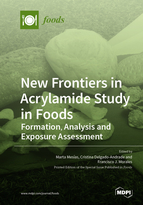New Frontiers in Acrylamide Study in Foods: Formation, Analysis and Exposure Assessment
A special issue of Foods (ISSN 2304-8158). This special issue belongs to the section "Food Quality and Safety".
Deadline for manuscript submissions: closed (31 March 2020) | Viewed by 52150
Special Issue Editors
Interests: food science; Maillard reaction; food safety; thermal food processing; chemical contaminants
Special Issues, Collections and Topics in MDPI journals
Interests: maillard reaction; glycation; chemical process contaminants; acrylamide; bioaccesibility; in vivo effects
Special Issues, Collections and Topics in MDPI journals
Interests: food quality; food safety; thermal processing; Maillard reaction; glycation; process contaminants; acrylamide; advanced glycation end-products; melanoidins
Special Issues, Collections and Topics in MDPI journals
Special Issue Information
Dear Colleagues,
Acrylamide is a chemical contaminant that naturally originates during the thermal processing of many foods. Since 2002, worldwide institutions with competencies in food safety have promoted activities aimed at updating knowledge for a revaluation of the risk assessment of this process contaminant. EFSA ruled in 2015 that the presence of acrylamide in foods increases the risk of developing cancer in any age group of the population. Commission Regulation (EU) 2017/2158 establishes mandatory mitigation measures for the food industry and reference levels to reduce the presence of acrylamide in foods and, consequently, its harmful effects on the population.
This Special Issue is open to contributions aimed at exploring recent advances on the acrylamide issue in foods that includes novel insight on its chemistry of formation and elimination, effective mitigation strategies, rapid monitoring techniques, the risk/benefit approach, exposure assessment, in order to enhance our understanding for this process contaminant and its dietary exposure.
Dr. Marta Mesías
Dr. Cristina Delgado-Andrade
Dr. Francisco J. Morales
Guest Editors
Manuscript Submission Information
Manuscripts should be submitted online at www.mdpi.com by registering and logging in to this website. Once you are registered, click here to go to the submission form. Manuscripts can be submitted until the deadline. All submissions that pass pre-check are peer-reviewed. Accepted papers will be published continuously in the journal (as soon as accepted) and will be listed together on the special issue website. Research articles, review articles as well as short communications are invited. For planned papers, a title and short abstract (about 100 words) can be sent to the Editorial Office for announcement on this website.
Submitted manuscripts should not have been published previously, nor be under consideration for publication elsewhere (except conference proceedings papers). All manuscripts are thoroughly refereed through a single-blind peer-review process. A guide for authors and other relevant information for submission of manuscripts is available on the Instructions for Authors page. Foods is an international peer-reviewed open access semimonthly journal published by MDPI.
Please visit the Instructions for Authors page before submitting a manuscript. The Article Processing Charge (APC) for publication in this open access journal is 2900 CHF (Swiss Francs). Submitted papers should be well formatted and use good English. Authors may use MDPI's English editing service prior to publication or during author revisions.
Keywords
- Acrylamide
- Chemical process contaminants
- Maillard reaction
- Food safety
- Risk/benefit
- Mitigation
- Exposure









